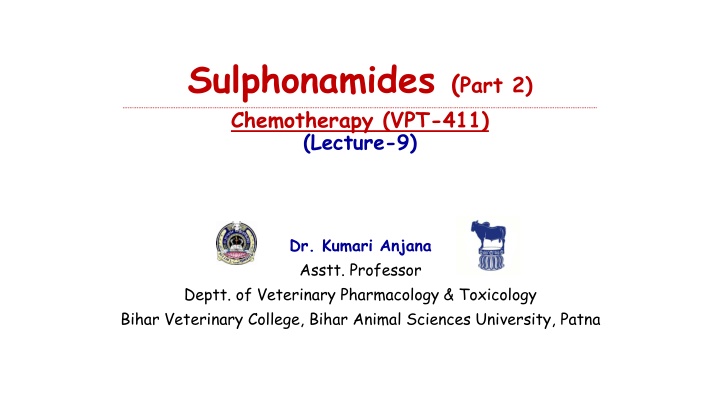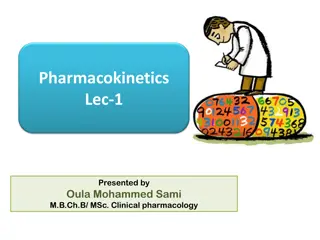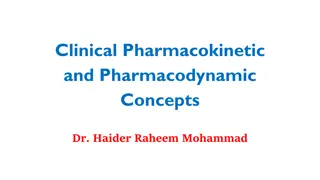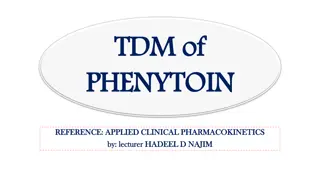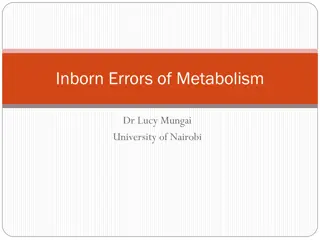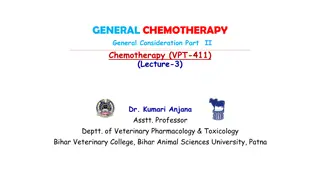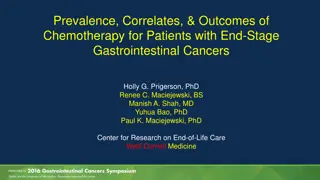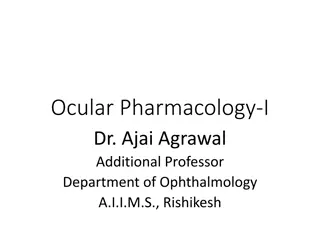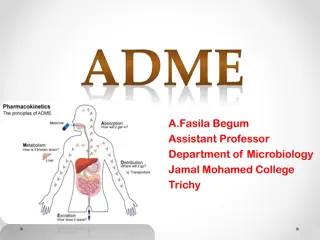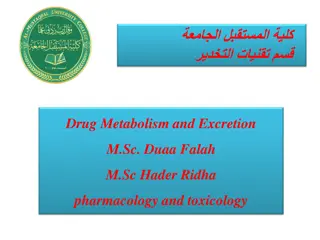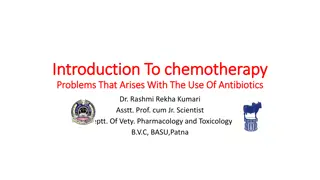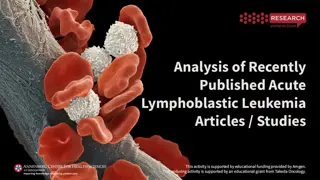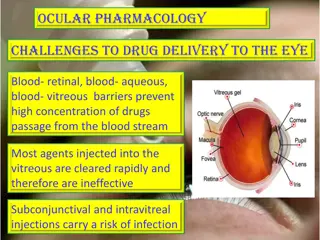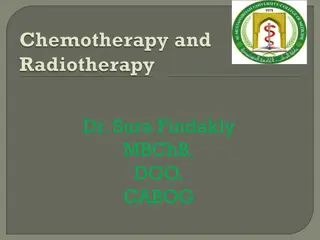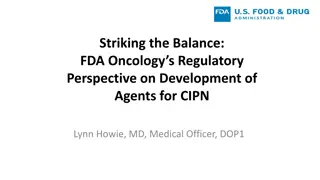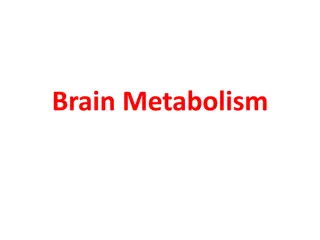Sulphonamides in Chemotherapy: Pharmacokinetics, Metabolism, and Effects
Sulphonamides play a crucial role in chemotherapy by affecting pharmacokinetics, distribution, metabolism, and excretion in various species. Understanding these aspects is essential for their effective use in clinical settings. This comprehensive lecture covers topics such as absorption, distribution, metabolism differences among herbivores and carnivores, acetylation pathways, and antagonists of sulphonamides. It also discusses clinical uses, side effects, and synergists associated with these important drugs.
Download Presentation

Please find below an Image/Link to download the presentation.
The content on the website is provided AS IS for your information and personal use only. It may not be sold, licensed, or shared on other websites without obtaining consent from the author.If you encounter any issues during the download, it is possible that the publisher has removed the file from their server.
You are allowed to download the files provided on this website for personal or commercial use, subject to the condition that they are used lawfully. All files are the property of their respective owners.
The content on the website is provided AS IS for your information and personal use only. It may not be sold, licensed, or shared on other websites without obtaining consent from the author.
E N D
Presentation Transcript
Sulphonamides (Part 2) Chemotherapy (VPT-411) (Lecture-9) Dr. Kumari Anjana Asstt. Professor Deptt. of Veterinary Pharmacology & Toxicology Bihar Veterinary College, Bihar Animal Sciences University, Patna
Content of the chapter Sulphonamides Pharmacokinetics Antagonist Synergists Clinical uses Side effects of Sulphonamide Potentiated Sulfonamides Nitrofurans
Pharmacokinetics Absorption Sulfonamides following oral administration are- rapidly and completely absorbed from the GI tract in dogs and cats; whereas ruminants take much longer time and oral absorption in pigs and horses is intermediate. Distribution: Sulphonamides are widely distributed throughout the body and into many soft tissue including the CNS (cerebrospinal fluid) and joints (synovial fluid). Binding to plasma protein (albumin) varies from sulphonamide to sulphonamide and from species to species and ranges from 15 -90%.
Metabolism Herbivorus metabolises sulphonamide at a faster rate and more extensively than carnivores and omnivores. Acetylation of NH2 group at N4 position is a major mechanism of metabolism. Acetylation is the major pathway by which sulphonamides are metabolised in most of species. Acetylated metabolite is major urinary metabolite in cattle sheep and swine. Canine lack ability to acetylate aromatic amines, and alternative metabolic pathway are involved in metabolism of sulphonamide.
The acetylated derivatives have little antibacterial activity, but contribute to adverse effects. Triplesulfa: Most of the N4 acetylated Sulfonamides, except the sulfapyrimidine derivatives (Sulfadiazine, Sulfadimidine) are less soluble in acidic urine, precipitate in the tubules and cause crystalluria. Sulfamerazine and Excretion: Most of the Sulfonamides are excreted mainly in urine through glomerular filtration.
Antagonist of sulphonamides Compounds (procaine, penicillin. containing butacaine PABA and nucleus benzocaine), such procainaide as local anesthetics and procaine Nicotinamide, folic acid and choline and their precursors. Gelatin, albumin, peptone and serum protein (the sulfa drugs bind). Antibacterial action is neutralized in the presence of pus or tissue breakdown products (contain thymidine and purines which are utilized by bacteria bypassing the need of folic acid).
Synergists of Sulfonamides Diaminopyrimidine (DAP) derivatives like trimethoprim act synergistically with sulfa drugs. It act by inhibiting dihydrofolate reductase (sequential blockade) in PABA-Nucleic acid synthesis pathway.
Clinical uses of Sulfonamides Sulfa prevention and treatment of acute systemic and local tract, topical) infection. The diseases cured by sulfonamides are: Actinobacillosis, Actinomycosis, Strangles (horses), Coccidiosis, Mastitis, Metritis, Colibacillosis, drugs are used for the Infectious polyarthritis, Infectious keratitis, Pneumonia, Respiratory infection, Urinary tract infections, Prododermatitis, Toxoplasmosis Meningitis and Foot rot. (GI, urinary
Toxicity Acute toxicity: Rare Chronic Toxicity: Haematological alteration Poultry: Drop in egg production, Abnormal eggs (rough thin shelled), agranulocytosis and anaemia are observed in poultry. Dog: cyanosis. Cattle: jaundice and neuritis.
CrystallUrea Keratoconjuctivitis sicca Hypersensitivity Hepatic necrosis Hypoprothrombinemia Blood Dyscrasias Thyroid metabolism disorders Skin reaction
Renal Toxicity/Crystallurea It is characterized by crystalluria, haematuria and obstruction of renal tubules. The drugs crystallize in acid urine. Crystalluria is more common with rapidly excreted sulfonamides than those excreted slowly. The renal damage is also more common with their acetylated derivatives (due to less solubility in acid urine) as compared to their glucuronide or sulfate conjugates, which are highly soluble.
clinical signs of renal impairment include crystalluria, renal colic, repeated attempts to urinate and elevated BUN levels. Crystalluria is more common in carnivores (Dog/Cat), which excrete acid urine than in herbivore, which excrete alkaline or neutral urine. Adequate water intake and alkalization of urine (sodium bicarbonate) and reducing the dose rates or by using triple Sulfa reduce the risk of crystalluria.
Keratoconjunctivitis sicca(KCS) KCS also known as Dry Eye. It is characterised by lack of adequate tear production resulting in ocular inflammation, irritation, Susceptibility to infection. Commonly reported in Dog treated with sulfasalazine, sulfadiazine and sulfamethoxazole.
Hypersensitivity : Reaction may be caused by either sulfadiazine, sulfadimethoxine and sulfamethoxazole. Lesions include glomerulopathy, polymyositis, polyarthritis, skin rash, skin eruptions, fever, hepatotoxicity, thrombocytopenia, neutropenia and anaemia, Hypothyroidism: Both sulfamethoxazole and sulfadiazine have been associated with hypothyroidism in Dog. The effect is caused ability of sulphonamide to inhibit thyroid peroxidase activity.
Hypoprothrombinemia: Sulfaquinoxaline is unique among sulphonamide in that it can induce in animals within 24 hr after dosing by lengthening prothrombin times. Anemia and thrombocytopenia: Anemia induced by trimethoprim sulphonamide combination may be due to decreased serum folic acid level which may be due to inhibiting the folate bacteria. production by intestinal
Potentiated Sulfonamides Sulfonamides + trimethoprim = Potentiated Sulfonamides (potentiates the antibacterial action) Trimethoprim: It is a diaminopyrimidine derivative. The antibacterial spectrum of trimethoprim is similar to sulfonamides, in addition also effective against organisms like S.typhi, E.coli, Klebsiella, haemophyllus etc. some sulfonamide resistant It is a bacteriostatic drug and acts by selectively inhibiting bacterial dihydrofolate reductase enzyme.
Its combination with sulfonamides results in potentiation of antibacterial action by sequential blockade at two steps in bacterial folate metabolism in nucleic acid synthesis. Trimethoprim, resembling pteridine moiety of folate, selectively blocks bacterial dihydrofolate produces bacteriostatic effect. reductase (DHFRase) and Individually both sulfonamide and trimethoprim are primarily bacteriostatic, but their combination is bactericidal.
The common combinations are (in a ratio of 1:5) trimethoprim + sulfamethoxazole (cotrimoxazole), trimethoprim + sulfadoxine or trimethoprim + sulfadiazine. The combination can be given either orally (rapid absorption) or parenterally and also reduces the toxicity of sulfonamides. The antibacterial spectrum of the potentiated sulfonamides covers both Gram positive and Gram negative organisms (Actinomyces, Bacillus anthracis, Brucella, cornyebacterium, E. Coli, Haemophilus, Klebsiella, Pasteurella, Proteus, Salmonella, Staphylococci and Sterptococci). Trimethoprim has 50,000 times more inhibitory effect against bacterial DHFRase than against the mammalian enzyme. Therefore, it does not interfere with folate metabolism in mammals at antibacterial concentrations.
Nitrofurans These are a group of synthetic antibacterial compounds which contain a furan ring to which a nitro group is attached. The 5-nitro group is essential for their antibacterial action. They are broad spectrum antibacterial. Effective against both Gram +ve and Gram -ve bacteria (but mainly used against Gram negative bacteria like E.coli, Salmonella, Klebsiella and Bacteroides species) and also against Coccidia, Giardia and amoebae.
Bactericidal or bacteriostatic in action. They act by inhibiting the enzymes necessary for the carbohydrate metabolism of bacteria. They are also thought to be converted to some metabolites (in bacterial cells) which interfere with the function of DNA.
The antibacterial activity of nitrofurans is reduced in the presence of blood, pus and milk. Toxic manifestations of these drugs include vomition, diarrhea, peripheral neuritis, disturbances. allergy and ocular These drugs are not used systemically because of toxicity but used for control of local or topical infections.
Nitrofurazone Main indications include treatment of bovine mastitis, bovine metritis and skin, burn and wound infections. It is also used as feed additive @ 0.05% to control intestinal bacterial and coccidial infections.
Nitrofurantoin It is mainly used as an urinary antiseptic for the prevention and treatment of urinary tract infections particularly in small animals. It is concentrated in acid urine (not precipitated), hence beneficial in dog @ 4-5 mg/kg, orally thrice daily for 5-10 days. Also used in calves and horse @ 10 mg/kg/day, orally for 10 days.
Furazolidone It has broad range antimicrobial spectrum; effective against both Gram positive and Gram negative bacteria and Eimeria and Histomonas spp. It is mainly used orally to treat enteric infections. Calves: @ 10-12 mg/kg, orally twice a day for about a week; Poultry @ 0.04% in feed for 10 days.
Furaltadone It is easily absorbed from GIT and has medium antibacterial spectrum. It is used to treatment: bovine mastitis @500 mg/quarter intramammarily; strangles in horse @ 13 mg/kg. IV for 5 days) and salmonellosis in chickens @0.04% in drinking water.
Sulphones Dapsone: It is chemically related to sulphonamides. It is effective against Mycobacterium leprae. DOC in leprosy. It is not used in other diseases due to its potent toxicity.
Summary Acetylation of NH2 group at N4 position is a major mechanism of metabolism. Triplesulfa: (Sulfadiazine, Sulfamerazine and Sulfadimidine) Compounds containing PABA sulphonamides. Trimethoprim act synergistically with sulfa drugs. Toxicity - CrystallUrea Keratoconjuctivitis sicca Hypersensitivity nucleus- Antagonist of
